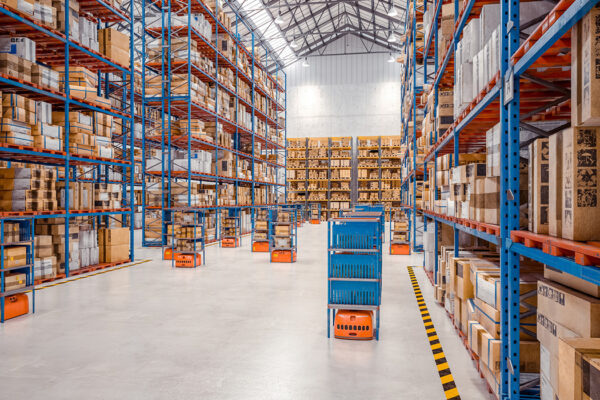Toonaangevend in logistieke oplossingen
Warehouse automation
The next step to working more efficiently
Automating warehouse processes is the next step to working more efficiently for many companies. But what exactly does warehouse automation entail and how can it help your organization? We explain how we can make your warehouse more efficient and profitable.
Why warehouse automation at DatAction?
With years of knowledge in the field of automating and making warehouses more efficient, you have a reliable partner in DatAction. We support your organization in automating and optimizing warehouse processes. We do this ourselves and with the help of our partners. So you have all the necessary expertise in-house. We provide you with consultancy, the implementation of the processes and solutions, and stay involved with our support.
The benefits of warehouse automation
Saving precious time
Automating your warehouse brings a number of great benefits. For starters, the cost and efficiency of your warehouse processes. Imagine an employee constantly having to walk from point A to B in your warehouse. This takes up a lot of time that could be put to a better use. For example, when deploying warehouse automation, an AMR (Autonomous Mobile Robot) could drive from A to B to perform this task. This can improve the time of your employee and the operation. Thus, more can be done with the same number of people within the same time frame.
But a more accessible solution such as scanning more efficiently with wearables such as the ProGlove(link) can also save a lot of time. With a handheld scanner, an employee often has to perform small actions such as grabbing the scanner and looking at the screen. This may only take a few seconds, but calculated over hundreds of employees and a longer period of time, there are a lot to be gained here. These are some examples of how your warehouse could operate more efficiently.
Preventing errors
Automating and optimizing processes can also prevent many errors. Making a mistake in a warehouse process can be costly, which is why it is important to minimize the chance of errors.
Tight labour market
In addition, warehouse automation solves a common problem: the low recruitment of suitable personnel. In this tight labour market, it is difficult to find good personnel. When you choose to (partially) automate your warehouse, in many cases this means that you also need fewer employees and can still grow.
The implementation duration
The answer to this question depends on a number of factors. For example, it obviously depends on the extent to which you want to automate your warehouse. The more adjustments have to be made, the longer it will take. In addition, the time the client has available also has a great influence on the process. We work closely with the client in terms of reviewing processes and testing the automation. The more time the client has available, the faster the implementation will go. Take into consideration a lead time of months. DatAction strives to work as efficiently and quickly as possible so that you can experience the conveniences of warehouse automation as soon as possible.
This is what you can expect in terms of payback time
The payback period for an investment in warehouse automation is always calculated when you purchase a solution from DatAction, and it is often around two years, depending on the solution. In the example of an AMR, there are several factors that affect the speed of payback on your investment.
It is important to have an overview of how much time is currently lost by walking from A to B. The more time that can be reassigned to a robot, the faster the investment can be recouped. Workers can now work more efficiently.
Workers’ labour costs also come into play. In many cases, a robot will be a lot cheaper than an employee. The higher the cost of an employee, the faster the investment will be recouped.
In addition, the number of shifts are also influential. A robot can work continuously. If your warehouse processes are done in for example three shifts, you can save significantly by using an AMR. The more shifts the robot can run, the shorter the payback period will be.
The different gradations in warehouse automation
Digitization
The first step to automating your warehouse is often digitizing processes that were previously done with pen and paper. Think for example of barcode scanners, tablets, and printers. Process-wise, little changes here, but work is made easier for warehouse staff.
Digitization with process change
Consider voice picking, for example. The method of order-picking is being digitized and with that, the processes must also be adapted. How is the voice picking process set up, how is it controlled and what happens in the software? We are happy to support you in these process changes.
Automation
The highest degree is the automation of your warehouse. Think of robots and machines that can take over the work of your employees. Processes are automated and work can be done significantly more efficiently.
Are you interested in optimizing or automating your warehouse processes? DatAction’s experts will be happy to help you. Get in touch now.
Your issue
You submit your issue to us, and we will look at what is the best solution for it.
Warehouse quick scan
To make the best estimate for the best solution for your warehouse, we would like to visit you. During our visit we can make a clear estimate.
Implementation
After the plan has been developed and agreed on by you, we begin the implementation of the project.

Opt for higher efficiency and fewer errors
Together with you, we get the maximum result from your warehouse or logistics centre.
Send a message or call us directly for an appointment.
Reinier Peelen
Project Engineer
Opt for higher efficiency and fewer errors
Together with you, we get the maximum result from your warehouse or logistics centre. Send a message or call us directly for an appointment.
Reinier Peelen
Project Engineer


